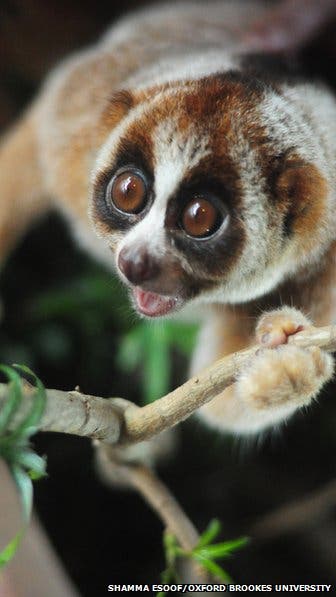Biologists have identified a new species of small nocturnal primates, part of the slow loris family, in Borneo’s forests. Don’t be fooled by its cute grim though, this tiny critter packs a punch, as its bite is poisonous and can cause harm to humans. Nevertheless, barely as it was discovered, scientists issued a warning to environmental agencies that the new slow loris is threatened with extinction due to habitat loss and trapping.

The new species of slow loris, named Nycticebus kayan, like most elusive nocturnal critters, has gone unnoticed because of its lifestyle. Professor Anna Nekaris of Oxford Brookes University in the UK, and Rachel Munds from the University of Missouri in Columbia, US had to survey great patches of forests in Borneo and the Philippines in search for the slow loris.
In the paper published in the journal American Journal of Primatology, the researchers describe the facial traits of the N. kayan that add up to form a sort of mask. The research has revealed there are actually four species of slow loris in the Philippines and Borneo, each with their own, subtly different but distinct head markings. Recently alone, two other slow loris species were identified, N. bancanus and N. borneanus, which were previously considered subspecies of N. menagensis.
The N. kayan is already is already threatened, unfortunately, at the hands of deforestation and poaching. It’s not its fur or other commodities that makes it attractive for poachers, but its cuteness, which makes it a prime candidate on the illegal pet-trade market in Asia. The N. kayan delivers a fierce blow, being one of the few mammals with a toxic bite, so captive animals often have their canine and incisor teeth pulled out. This puts them at great risk since they can’t chew food properly, ultimately causing death. The toxin is powerful enough to potentially cause fatal anaphylactic shock in people.
“Unfortunately, in addition to habitat loss to deforestation, there is a booming black market demand for the animals. They are sold as pets, used as props for tourist photos or dismembered for use in traditional Asian medicines,” Munds said.
She added that technological advances had enabled the team to identify it as a separate species. “Historically many species went unrecognised as they were falsely lumped together as one species. While the number of recognised primate species has doubled in the past 25 years some nocturnal species remain hidden to science.”


